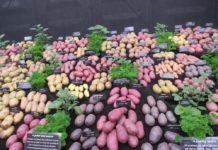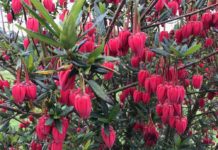Great gardens are not just beautiful but have other special qualities, such as the ability to relax and heal and rejuvenate. Others have the ability to transport you to another place and time and give a powerful sense of transcendence and other-worldliness.
We travelled to the outskirts of Dublin today to visit two unique, beautiful and much loved gardens that exemplify this truth.
The first was Knockrose, a hidden, protected garden, located on a centuries-old estate and today owned by Tom and Trish Farrell.

The property has been in Trish’s family for four generations and the garden was started by her mother when Trish was a child.
A wall on the property is edge of “the pale” the traditional border of Dublin and Wicklow that gave meaning to the term “beyond the pale.”

Tom greeted my group at the entrance off the main road and walked with us up a long curving lane to the house. On the way, he explained how the garden was a deep, source of spiritual Ley lines and had a history of being a healing place and a spiritually uplifting place for many visitors.

Mushroom shaped granite objects, made by Cistercian monks in the 11th century and used as baffles to protect grain from mice and rats, were gathered on the property and grouped together to create a mystic centrepiece in the centre of the garden.

We started out visit by walking through beautiful iron gates made from the wheels of an old milk-churn cart.

To the right, we found a huge Chilean lantern tree (Crinodendron) covered in masses of red dangling lantern-like flowers.
The small stone house was covered with Clematis montana that swept down and also covered the top of a low stone wall.

Ethereal, wire-sculptural art-pieces by local artist Susan Cuffe have been dotted around the garden and add a ghostly-spirit presence to the landscape.

Once inside the garden, we started our journey up a slope, first passing a small enclosed courtyard with beautiful mix of ceanothus, clematis and helianthemum and a giant mound of white flowered potentilla.

We continued to circle around the garden, passing a lower lawn with two bright yellow metal chairs on it next to a lovely water course.
Steps took us up and into a small side, walled garden where we found the poignant metal tripod structure used to support a “famine pot” at the time of the potato famine. The large pot, used to cook soups and stews to feed the poor, has been sunk into the ground and turned into a pretty water feature.

Climbing the hillside, we past clumps of false Solomon seal and wallflowers and eventually came to the ring of granite mushroom-shaped objects that were used by monks to protect crops in the Middle Ages.

Here we found a beautiful Prunus serrulata with its magnificent shiny mahogany-like bark and beyond the mushroom objects a tall laburnum tree and in another corner a lovely weeping willow-leaf pear tree in front of a towering Crinodendron fighting for its life against a sprawling and smothering clematis.

Salvaged blue Victorian benches have been placed in a few spots around the garden to create inviting sitting spots. Once people get settled, Tom says they often feel like sitting for hours.

On our way back down through the garden, we were amazed by the colourful bark of myrtle trees and impressed by the giant stands of purple phormium and the scent of deciduous azaleas.
Cute hedgehog sculptural works have been tucked into borders, under the flowers of dwarf rhododendrons and low perennials.

All the time we were in the garden, the wind wipped wildly around the outside, roaring in the tree tops and makes a big show of itself. But inside the garden, there was perfect calm and tranquility – not a leaf was stirred. The contrast was quite striking.
Feeling rested and revived by the beauty and charm and peace of the garden, we said our farewells to the Farrells and head off to see our next garden at Corke House, which was built in the 1820s as an Italianate villa where a cork tree was planted because at the time olives and more exotic plants were not available.
Today the cork is a massive tree that collapsed many years ago and now lays, huge and impressive on the ground with massive branches reaching out in all directions.

The house was once part of the estate owned by Miss Augusta Elizabeth Magan, one of the richest women in Ireland, who was left standing at the alter by her fiancé when she was 19.
Traumatized by the betrayal, she locked herself up in a house on St. Stephen’s Green but kept the wedding banquet table set and continued to wear her wedding dress.

Apparently, Charles Dickens was in Dublin in 1858 and heard the story of Miss Megan and used her as the basis for his character Miss Haversham in Great Expectations, published in 1861.
Today, Corke House is owned by architect Alfred Cochrane, who lives most of the time in Rome and speaks perfect Italian.

He decided to add to the pronounced Mediterranean style of the garden by adding lush stands of bamboo, cordylines, tree ferns and phormiums as well as dense drifts of silver leafed senecio.
Cochrane also salvaged architectural remnants from Glendalough House, an 1830s Tudor manor, when it was being demolished and added the bits to his garden to create a picture of crumbling ruins from another age.

But Cochrane’s greatest contribution was to use his considerable architectural skills to create two well-defined lines of view that give the garden its strong definition with paths and buildings elegantly framed by the unambiguously structural plant material.
“I like to think of the garden as a kind of architectural theatre set that has slowly become overgrown, “ Cochrane told us.

In the garden, we also enjoyed seeing large examples of Nothofagus (southern beech) and the Oriental plane (Plantanus orientalist), and lovely myrtle trees, beautiful Atlantic blue spruce and soaring katsura trees.
From Corke House, we headed back into Dublin to explore more of the delights of the Irish capital.























